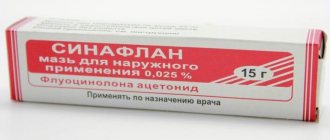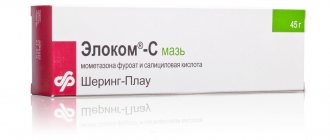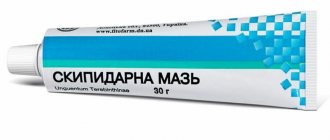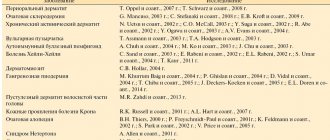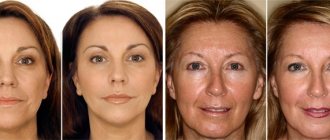Pharmacodynamics and pharmacokinetics
The main target of the drug is a component of the fungal cell membrane - ergosterol . The active component Bifonazole suppresses the process of synthesizing ergosterol at two stages of its formation, which damages the cell membrane of the fungal cell (functional and structural effects).
Bifosin is active against dermatophytes (fungicidal effect on epidermophyton, trichophyton and microsporum), mold and yeast-like fungi (fungistatic effect). The drug has no effect on enterococci .
The minimum amount of the drug that has an effective antifungal effect is 5 ng/ml. A fungicidal effect is observed against fungi of the genus Candida at a drug concentration of 20 ng/ml; at lower concentrations a fungistatic effect is observed.
Bifosin
If the smooth skin of the hands, feet, and large folds are affected by mushrooms, the drug ointment is applied in a thin layer once a day in the evening before bedtime, followed by rubbing into the lesions. The duration of treatment with the drug depends on the pathogen, size and location of the lesion.
The solution is applied once a day in the evening, before bedtime, in a thin layer to the affected area of the skin and rubbed in. For an area the size of a palm, a strip of cream 1 or 0.5 cm long or a few drops of solution (about 3 drops) is usually sufficient. The duration of treatment for mycoses of the feet and interdigital spaces of the foot is 3 weeks; mycoses of the body, hands and skin folds - 2-3 weeks; versicolor versicolor, erythrasma - 2 weeks; superficial skin candidiasis - 2-4 weeks. The solution is convenient for the treatment of mycoses of the scalp and is applied to a previously shaved lesion. The course of treatment is 4 weeks.
After using the drug solution and the inflammatory phenomena have subsided, treatment with cream is continued, then powder is applied.
The course of treatment with the drug depends on the nature of the disease and is 2-5 weeks; for foot hyperhidrosis, powder is used - 2-3 weeks. After the elimination of clinical manifestations of mycosis, treatment is continued for 10-15 days, using a cream, solution or powder once a day to prevent relapse.
An ointment or cream is used to remove nails for onychomycosis with a simultaneous antifungal effect. An amount of the drug that covers the entire affected nail is applied in a thin layer once a day from a dosing device. After applying ointment or cream, the nails of the fingers or toes should be covered with a plaster and bandage for 24 hours. The bandage must be changed every day; in this case, after removing the bandage, the finger or toe should be immersed in warm water for 10 minutes. After this, the softened, infected nail tissue is removed using a scraper. The treated nail is then dried, the cream is applied again and covered with a ready-to-use patch. Treatment is continued until the nail bed becomes smooth and all of its softened part is removed (approximately 7-14 days, depending on the size of the affected area and the thickness of the nail). The ointment or cream only affects the affected part of the nail. If irritation occurs, the skin around the nail should be lubricated with zinc paste. To treat small nails, the patch should be cut in half. After the nail is removed, paste therapy should be carried out. Although clinically inflammatory phenomena during treatment resolve quickly (itching of the skin in the affected areas disappears by day 5, inflammatory phenomena by 12-13 days, peeling by 13-14 days of treatment with the drug), it is necessary to continue treatment for at least 3-4 weeks. to ensure the sanitation of foci of infection.
Indications for use
The drug is prescribed for lichen versicolor, favus, trichophytosis of the scalp and smooth skin, microsporia , erythrasmas, rubrophytosis, inguinal epidermophytosis , mycotic lesions of the hands and feet.
Bifosin cream is prescribed for onychomycosis. The medication is effectively used for candidiasis of the genitals, skin, nail plates, nail folds, hyperhidrosis of the feet and interdigital diaper rash .
Directions for use and doses
Externally, the cream or solution is applied to the lesions in a thin layer, lightly rubbing, 1-2 times a day. In the presence of exudative forms of lesions, treatment begins with the use of a solution, after reducing acute inflammatory phenomena, a cream is used, then a powder is applied. Duration of treatment for rubrophytia - 2-5 weeks, microsporia of smooth skin - 2 weeks, for damage to smooth skin and external genital organs - 2-4 weeks, nail folds and nails - at least 3-4 months, for pityriasis versicolor, erythrasma - 3 –4 weeks, for foot hyperhidrosis (use powder) – 2–3 weeks.
After the elimination of clinical manifestations of mycosis, treatment is continued for 10–15 days, using a cream, solution or powder once a day to prevent relapse.
Instructions for use of Bifosin (Method and dosage)
Apply at night once a day.
Treatment of mycosis of the interdigital spaces and feet takes approximately 3 weeks; for mycotic lesions of the hands, body and folds, antifungal therapy is carried out for 2-3 weeks. For erythrasma and lichen versicolor, the medication is prescribed for 2 weeks; for candidiasis of the skin (superficial form), bifonazole is used for 2-4 weeks.
Bifosin cream, instructions for use
Apply once a day in a thin layer (preferably before bedtime) if the skin of the feet, hands and folds is affected. The course of therapy largely depends on the area of the lesion, the location of the disease and the main pathogen.
To treat an area the size of your palm, approximately 0.5-1 centimeter of a strip of cream is required.
For onychomycosis, the cream is applied to the entire nail plate in a thin layer, after which it is covered with a plaster or bandage for a day. Before changing the bandage, it is recommended to place the finger in warm water for 10 minutes. The softened, infected part of the nail plate is removed using a special scraper. The nail is dried and the cream is reapplied and covered with a band-aid. The course is designed to completely remove the affected area of the nail plate. If irritation occurs, the skin around the nail is treated with zinc paste.
Instructions for the solution
It is recommended to rub in the Bifosin solution with gentle movements. Approximately 3 drops of solution are required to treat an area the size of your palm.
Bifosin solution is preferably prescribed for treating the scalp (it is recommended to shave the affected area first). The duration of antifungal therapy is 1 month. After the inflammatory reaction has subsided, treatment is continued by first prescribing a cream and then a powder.
Using powder
Hyperhidrosis therapy is carried out with Bifosin powder for 2-3 weeks. If the dynamics are positive, it is recommended to switch to the cream form of the drug (10-15 days).
Using Bifosin spray
It is necessary to sufficiently moisturize the affected areas of the skin.
Composition and release form
| Powder 1% | 100 g |
| bifonazole | 1 g |
| excipients: zinc oxide 15 g; corn starch; talc |
in polyethylene jars of 30 g.
| Solution for external use 1% | 100 ml |
| bifonazole | 1 g |
| excipients: polyethylene oxide-400 |
in dark glass dropper bottles of 15 g; 1 bottle in a box.
| Cream 1% | 100 g |
| bifonazole | 1 g |
| excipients: polyethylene oxide-400; polyethylene oxide−4000; polypropylene glycol |
in tubes of 30 g; 1 tube in a box.
special instructions
If antifungal therapy is insufficiently effective, additional examination of the patient is required (assessment of the endocrine and immune systems, state of microcirculation of the affected area). Correction of therapy based on the results of the examination is mandatory. Bifosin powder is prescribed to infants in exceptional cases and under the mandatory supervision of the attending physician. When treating onychomycosis, careful removal of the damaged area of the nail plate is important. The supplied patches cannot be reused. You can buy Bifosin at a pharmacy (no prescription form required).
Sinaflan ointment for external use 0.025% 10 g tube 1 pc. in Moscow
Latin name
Sinaflan pointment
International nonproprietary name
fluocinolone acetonide
Release form
Ointment for external use
Package
10 g - aluminum tubes (1) - cardboard packs
Description
The ointment is light yellow to yellow in color with the smell of lanolin.
pharmachologic effect
GCS for external use. It has anti-inflammatory, antiallergic, antiexudative and antipruritic effects. Reduces the manifestations or eliminates the inflammatory skin reaction.
Indications
Psoriasis, lichen planus, seborrheic dermatitis, eczema of various origins and localization (including eczema in children), neurodermatitis, skin itching of various origins, allergic skin diseases, discoid lupus erythematosus, first degree burns, sunburn, insect bites.
Directions for use and doses
Externally. A small amount of the drug is applied to the skin, previously wiped with a swab moistened with an antiseptic liquid, 2-4 times a day and lightly rubbed. If necessary, you can apply an occlusive dressing, leaving it on the affected surface for up to 3-4 days. It is not allowed to apply more than 2 g per day under a bandage. The duration of treatment depends on the nature of the disease and the effectiveness of therapy, usually 5-10 days. If the disease persists, the course of treatment can be extended to 25 days (after consultation with a doctor). In children, it is recommended to use the minimum effective dose, no more than 5 days.
Compound
1 g fluocinolone acetonide 250 mcg Excipients: propylene glycol, medical petroleum jelly, anhydrous lanolin, ceresin.
Contraindications
Bacterial, viral, fungal skin diseases, skin tuberculosis, skin manifestations of syphilis, extensive psoriatic plaques, anogenital itching, trophic leg ulcers associated with varicose veins, skin tumors, pregnancy.
Use during pregnancy and breastfeeding
Contraindicated during pregnancy and lactation.
special instructions
Use only in short courses on small areas of skin. It is recommended to wear loose clothing during treatment. The drug should not be applied to the face. Avoid getting the drug into your eyes. When local infectious complications develop, it is used in combination with antimicrobial drugs. Influence on the ability to drive vehicles and operate machinery. No effect.
Side effects
Burning, itching, steroid acne, stretch marks, dry skin, folliculitis. With long-term use - skin atrophy, local hirsutism, hypertrichosis, telangiectasia, purpura, skin pigmentation disorders, alopecia, especially in women, secondary immunodeficiency (exacerbation of chronic infectious diseases, generalization of the infectious process, development of opportunistic infections). When applied to large surfaces, systemic manifestations are possible (gastritis, “steroidal” gastric ulcer, adrenal insufficiency, Itsenko-Cushing syndrome, “steroidal” diabetes mellitus, slowdown of reparative processes).
Drug interactions
Compatible with antimicrobial drugs. Reduces the activity of antihypertensive, diuretic, antiarrhythmic drugs, potassium supplements. Diuretic drugs (except potassium-sparing drugs) increase the risk of hypokalemia.
Storage conditions
In a place protected from light at a temperature not exceeding 25 ° C.
Bifosin's analogs
Level 4 ATC code matches: Daktarin
Oronazole
Isoconazole
Kandibene
Miconazole
Candide B
Nizoral
Kanesten
Mifungar
Ecodax
Econazole
Clotrimazole
Travogen
Bifonazole
Sebozol
Mycozolon
Mycozoral
Travocort
Mycospor
Mycospor Set
Can be called: Bifonazole , Mycospor , Bifasam .
